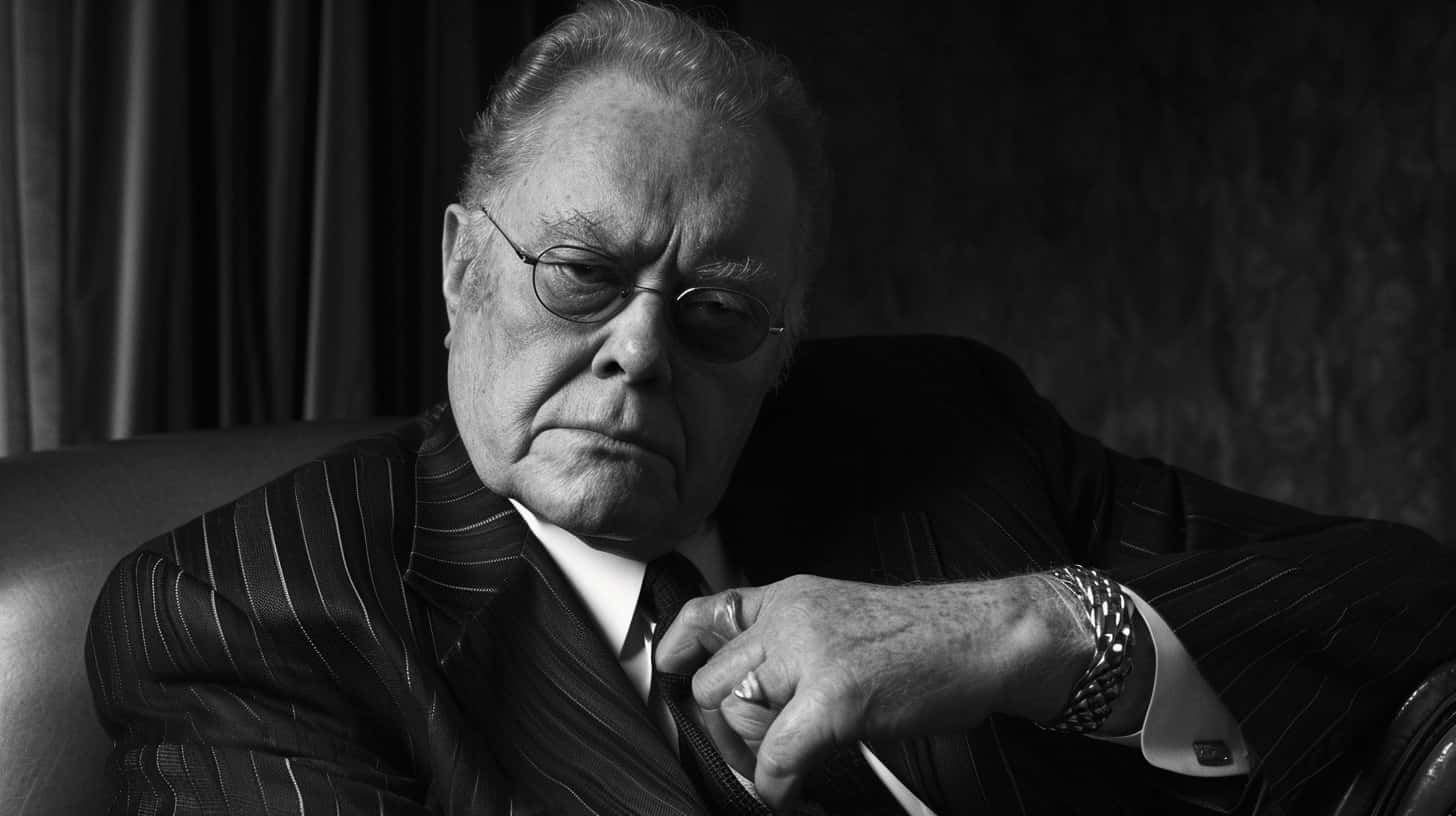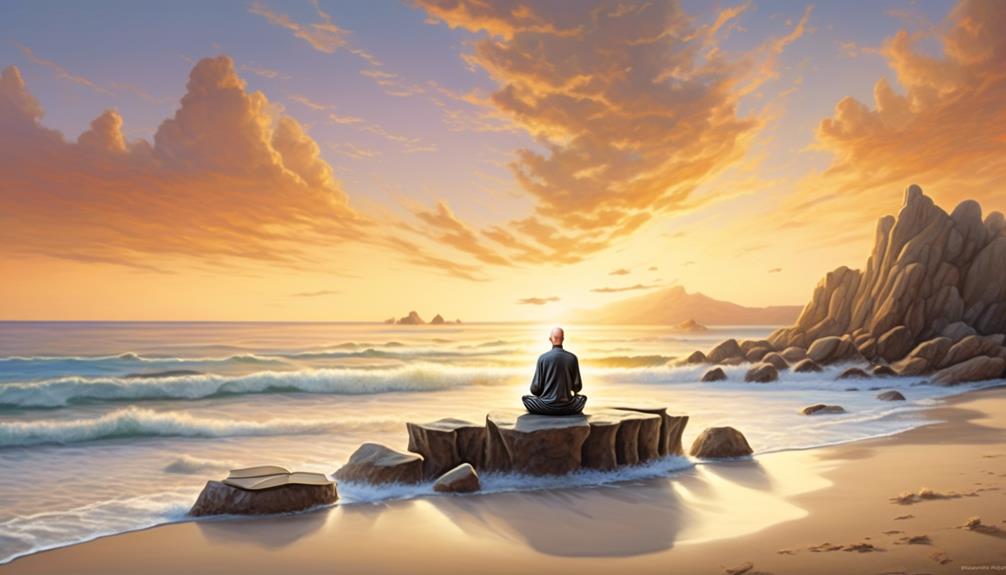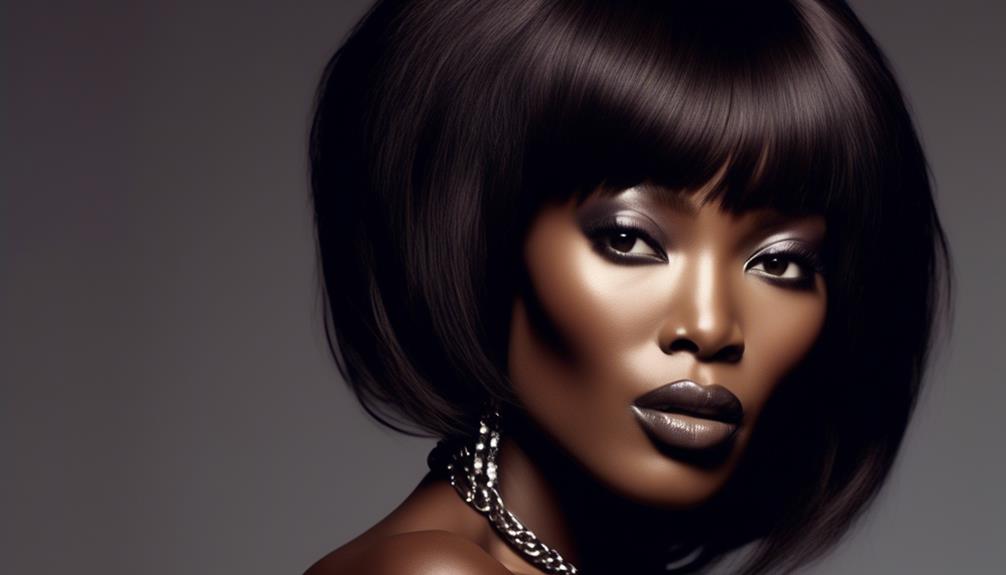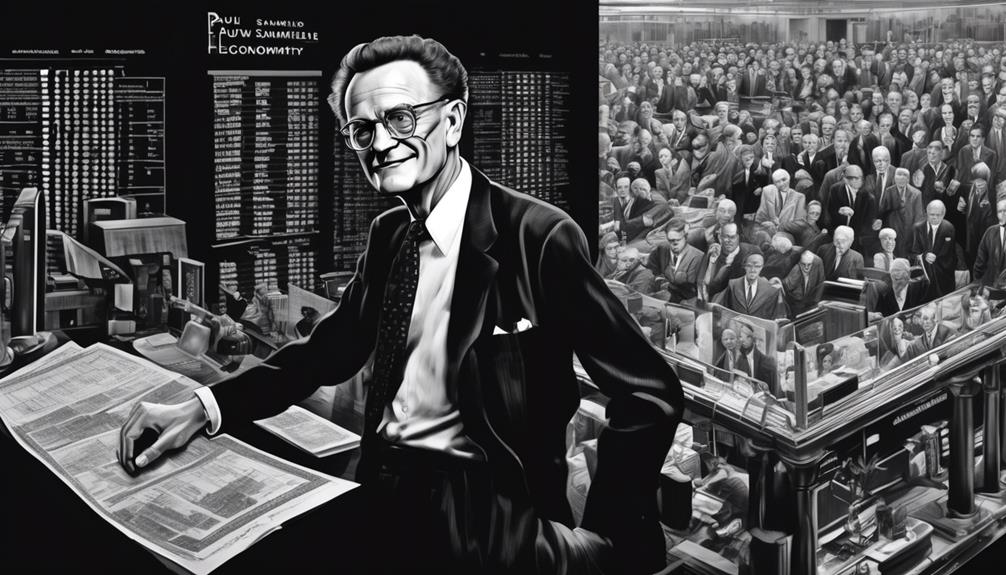Ever curious about the wisdom Larry Flynt, the renowned American media giant and creator of Hustler, shares with the world? Let’s peek into his famous sayings to reveal the secrets of his beliefs.
With a keen focus on freedom of speech, Flynt’s commentary on censorship challenges societal norms and sheds light on the power of his Hustler empire. Known for his controversial views on pornography and women’s rights, Flynt fearlessly presents his unfiltered thoughts on these subjects.
Furthermore, his provocative commentary on politics and religion provides a fresh perspective on these often sensitive topics. As we explore Flynt’s quotes, we gain a glimpse into his vision for the future of media and his enduring legacy as a prominent media mogul.
Key Takeaways
- Larry Flynt passionately championed freedom of speech and believed it should be protected at all costs.
- The Hustler Empire had a significant cultural impact by pushing boundaries and challenging societal norms.
- Flynt played a pivotal role in advocating for and defending the right to freedom of expression, expanding the scope of First Amendment protections.
- Flynt critiqued mainstream media for its biases, lack of diverse perspectives, and corporate influence, which undermines public trust and distorts reality.
Larry Flynt on Freedom of Speech
Larry Flynt, the controversial publisher of Hustler magazine, passionately championed the importance of freedom of speech throughout his life. His legal battles and impact on free speech activism have left a lasting legacy.
Larry Flynt’s legal battles were legendary. He faced numerous lawsuits and criminal charges throughout his career, all stemming from his provocative and controversial content. Despite the constant legal challenges, Flynt refused to back down. He firmly believed that freedom of speech was an essential right that should be protected at all costs. His unwavering commitment to this cause made him a symbol of defiance and resistance in the face of censorship.
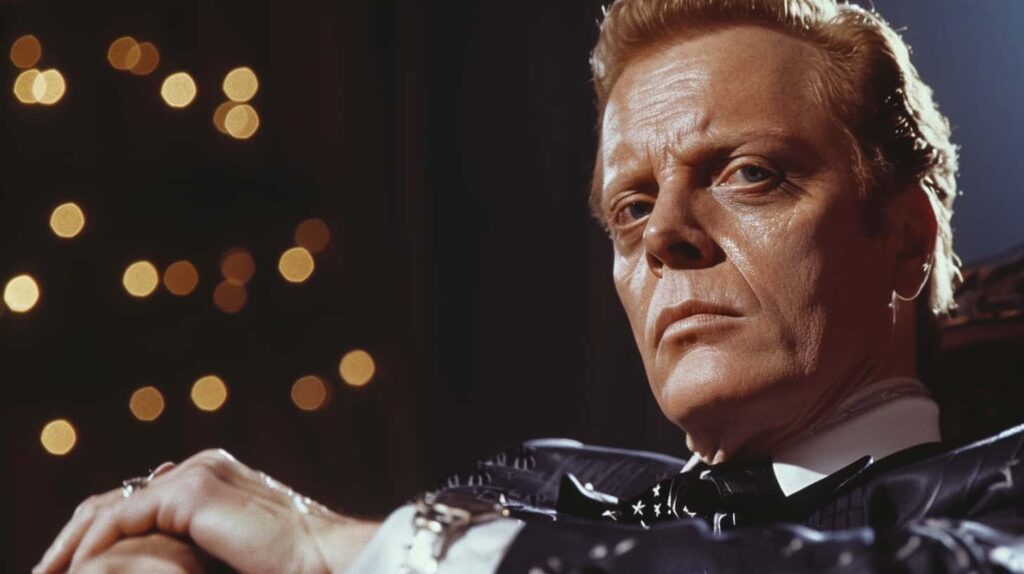
Flynt’s impact on free speech activism can’t be overstated. He pushed the boundaries of what was considered acceptable in mainstream media, sparking important conversations about censorship and the limits of artistic expression. By fearlessly challenging societal norms and legal restrictions, he paved the way for future generations of artists, writers, and journalists to express themselves freely.
Larry Flynt’s legacy as a champion of free speech continues to inspire and ignite debate to this day. His legal battles and unwavering commitment to this fundamental right serve as a reminder that the fight for freedom of speech is ongoing and requires constant vigilance.
Larry Flynt’s Take on Censorship
When it comes to censorship, Larry Flynt has been a strong advocate for freedom of expression. He believes that everyone should have the right to express their thoughts and ideas without fear of being silenced or censored.
Flynt has often spoken out against media censorship, arguing that it limits our ability to engage in meaningful discussions and explore diverse perspectives. His stance on censorship highlights the importance of protecting our right to free speech and ensuring that all voices are heard.
Freedom of Expression
Freedom of expression is a fundamental pillar of democracy, allowing individuals to openly express their thoughts, ideas, and beliefs without fear of censorship or reprisal. Larry Flynt, the famous American media mogul and Hustler publisher, is a staunch advocate for this essential right. Flynt firmly believes in the First Amendment, which protects freedom of speech and the press.
He’s faced numerous legal battles over the years, defending his right to express himself artistically through his explicit and controversial content. Flynt understands that artistic expression can push boundaries and challenge societal norms, but he argues that it’s crucial for the progress of society.
Media Censorship
As we shift our focus to the subtopic of media censorship, we enter the realm where the boundaries of freedom of expression are tested and the battle for unrestricted artistic representation continues. In today’s world, where media ownership is concentrated in the hands of a few powerful corporations, the issue of censorship becomes even more critical. Here are four key points to consider:
- Suppression of dissent: Media censorship can be used as a tool to silence voices of opposition and maintain the status quo.
- Threat to democracy: When the media is censored, it hampers the flow of information and limits the public’s ability to make informed decisions, undermining the principles of democracy.
- Internet censorship: With the rise of the internet, the battle against censorship has shifted online. Governments and corporations alike attempt to control and regulate the flow of information on the internet.
- Freedom of expression: Censorship hampers creativity and stifles innovation. It’s essential to protect the freedom of expression so that artists and creators can push boundaries and challenge societal norms.
The Power of Larry Flynt’s Hustler Empire
When it comes to the power of Larry Flynt’s Hustler Empire, there are two key points to consider.
First, Hustler’s cultural impact can’t be denied. With its explicit content and provocative articles, the magazine pushed boundaries and challenged societal norms.
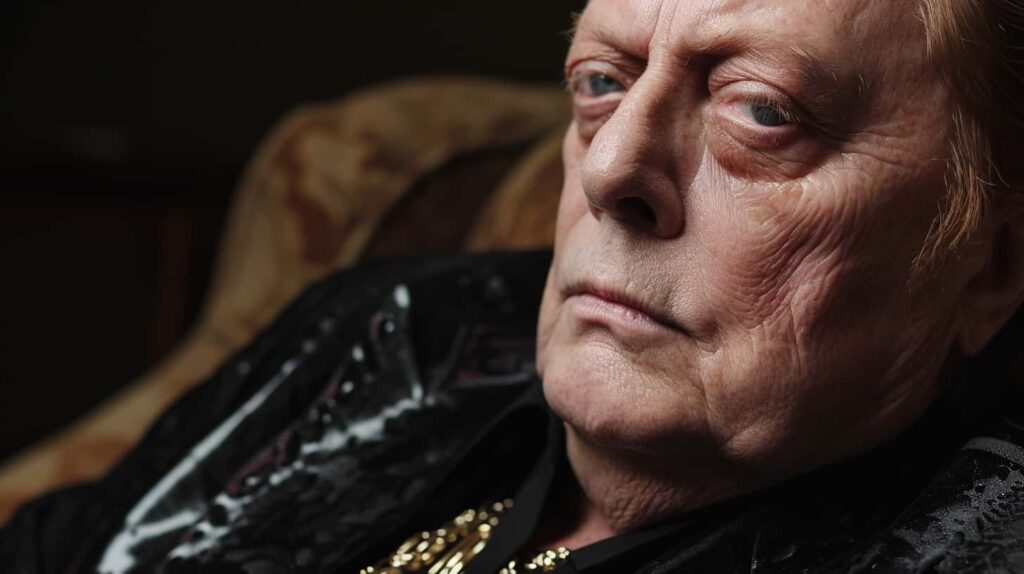
Second, Larry Flynt himself left behind a controversial legacy. While some admired his fight for freedom of speech, others criticized his exploitation of women and objectification of the female body.
The power of the Hustler Empire lies in its ability to both captivate and polarize audiences, making it a force to be reckoned with in the world of adult entertainment.
Hustler’s Cultural Impact
The impact of Larry Flynt’s Hustler Empire on popular culture can’t be underestimated. From its inception, Hustler magazine challenged societal norms and pushed the boundaries of sexuality. Larry Flynt’s unwavering commitment to free speech and the First Amendment made Hustler a platform for provocative and controversial content.
Here are four ways Hustler has left its mark on our cultural landscape:
- Redefining Sexual Expression: Hustler’s explicit and explicit depictions of sexuality challenged traditional notions and sparked conversations about sexual liberation and freedom.
- Opening Dialogues on Taboo Topics: Through its articles and editorials, Hustler tackled taboo subjects like interracial relationships, LGBTQ+ rights, and BDSM, creating spaces for dialogue and understanding.
- Shaping Feminist Discourse: While controversial, Hustler’s explicit content also sparked discussions on the objectification and empowerment of women, contributing to feminist discourse.
- Championing Free Speech: Larry Flynt’s battles with censorship and legal challenges not only protected the rights of adult entertainment, but also set important legal precedents for free speech in the media.
Hustler’s cultural impact is undeniable, and Larry Flynt’s vision continues to shape the conversation around sexuality and free speech today.
Larry Flynt’s Controversial Legacy
Larry Flynt’s controversial legacy as the mastermind behind the powerful Hustler Empire is one that continues to captivate and challenge societal norms, leaving an indelible mark on the world of adult entertainment and free speech. Flynt’s relentless pursuit of pushing boundaries and fighting for his right to express himself has resulted in numerous legal battles that have made headlines over the years. His bold and often provocative content has been met with both admiration and condemnation, but there is no denying the impact he has had on the landscape of free speech. Through his Hustler magazine and other ventures, Flynt has championed the idea that expression should know no bounds, sparking important debates about the limits of artistic freedom and the power of the First Amendment.
| Larry Flynt’s Legal Battles | Larry Flynt’s Impact on Free Speech |
|---|---|
| Supreme Court Case: Hustler Magazine v. Falwell | Challenged societal norms |
| Obscenity trials for explicit content | Sparked important debates |
| Fight against censorship | Championed artistic freedom |
| Legal battles for the right to express himself | Pushed the limits of free speech |
| Defender of the First Amendment | Left an indelible mark |
Larry Flynt’s Views on Pornography
Throughout his career, Larry Flynt has consistently expressed his unapologetic support for the adult entertainment industry. As a media mogul and publisher of Hustler, Flynt’s views on pornography have had a significant impact on society and the ongoing debate surrounding the industry. Here are four key insights into Flynt’s perspective:
- Free Speech Advocacy: Flynt firmly believed in the First Amendment and fought numerous legal battles to defend the right to free expression. He saw pornography as a form of speech and believed that adults should have the freedom to consume and create it without government interference.
- Challenging Social Norms: Flynt’s publications pushed the boundaries of what was considered acceptable in mainstream society. He believed that pornography could challenge societal norms and provide a platform for marginalized voices and sexual minorities.
- Economic Empowerment: Flynt argued that the adult entertainment industry offered economic opportunities for individuals who might otherwise face barriers in traditional employment. He believed that the industry provided a means for people to support themselves and their families.
- Sexual Liberation: Flynt viewed pornography as a tool for sexual liberation, challenging conservative attitudes towards sexuality. He believed that embracing sexual diversity and exploring one’s desires could lead to a more fulfilling and authentic life.
Larry Flynt’s views on pornography were controversial, but they played a significant role in shaping the ongoing discussion surrounding the adult entertainment industry and its relationship to free speech and personal freedom.
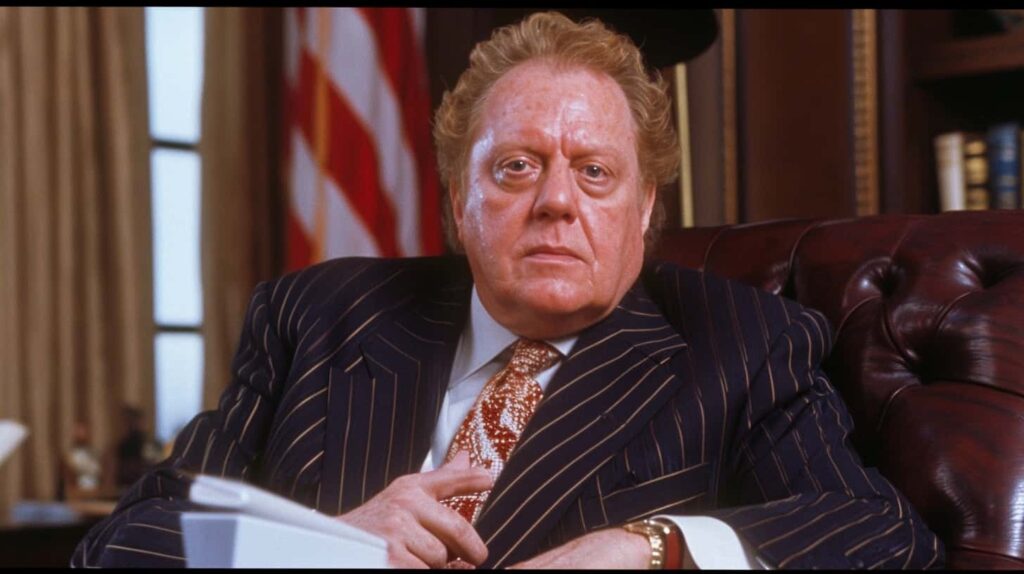
Larry Flynt’s Controversial Stance on Women’s Rights
As we delve into the controversial topic of Larry Flynt’s stance on women’s rights, it becomes apparent that his views on pornography intersect with broader discussions surrounding gender equality and the objectification of women.
Larry Flynt is an advocate for sexual freedom and has often faced feminist criticism for his controversial portrayal of women in Hustler magazine.
Flynt’s advocacy for women’s rights is a complex and contentious issue. On one hand, he argues that pornography is a form of free speech that empowers women to explore and express their sexuality. He believes that women should have agency over their own bodies and the right to engage in consensual sexual activities without shame or judgment.
However, Flynt’s critics argue that his magazine perpetuates harmful stereotypes and objectifies women for male gratification. They argue that his portrayal of women as sexual objects reinforces societal norms that contribute to the marginalization and oppression of women.
In the face of feminist criticism, Flynt has defended his magazine by stating that it’s a reflection of society’s sexual desires and fantasies. He claims that Hustler simply provides a platform for people to explore their sexuality and that it’s up to individuals to interpret and respond to the content.
While Flynt’s controversial stance on women’s rights and his advocacy for sexual freedom may spark debate, it’s important to consider the broader implications of his views on gender equality and the objectification of women.
Larry Flynt’s Impact on American Media
Larry Flynt revolutionized American media, leaving an indelible mark that challenged societal norms and pushed the boundaries of free speech. His impact on the American media landscape can be seen through his legal battles and his relentless pursuit of protecting and expanding the freedom of the press.
Here are four key ways Larry Flynt transformed American media:
- Defending the First Amendment: Flynt’s numerous legal battles, including the landmark Supreme Court case Hustler Magazine v. Falwell, solidified his role as a champion of free speech. His fight for the First Amendment set important precedents for the protection of controversial and provocative content.
- Redefining the boundaries of acceptability: With Hustler magazine, Flynt pushed the limits of what was considered acceptable in mainstream media. His explicit and controversial content challenged societal norms and sparked important conversations about censorship and personal freedoms.
- Giving a voice to the marginalized: Through his publications, Flynt provided a platform for marginalized communities, including women, LGBTQ+ individuals, and people of color. He brought their stories, perspectives, and experiences to the forefront, amplifying their voices in a predominantly homogeneous media landscape.
- Inspiring future generations: Flynt’s audacity and fearlessness inspired a new generation of media entrepreneurs and activists. His unapologetic pursuit of truth and freedom of expression continues to serve as a guiding light for those who seek to challenge the status quo and fight for a truly free press.
Larry Flynt’s impact on American media can’t be overstated. His legal battles and relentless pursuit of free speech have shaped the media landscape, paving the way for a more inclusive and diverse range of voices and challenging the traditional boundaries of acceptability.
Larry Flynt’s Influence on First Amendment Rights
Larry Flynt’s impact on American media includes a significant influence on First Amendment rights, reshaping the boundaries of free speech and challenging societal norms. Flynt, as a media mogul and publisher of Hustler magazine, played a pivotal role in advocating for and defending the right to freedom of expression. His bold and often controversial publications pushed the limits of what was deemed acceptable by society, sparking debates and legal battles that ultimately expanded the scope of First Amendment protections.
Flynt’s role in media activism can’t be understated. Through his publications, he fearlessly tackled taboo subjects and exposed the hypocrisy of those in power. His relentless pursuit of free speech rights led to landmark legal battles, such as the famous Supreme Court case, Hustler Magazine v. Falwell, which solidified the protection of parody and satire under the First Amendment.
While some may criticize Flynt’s explicit and controversial content, his contribution to the protection of free speech can’t be denied. By challenging societal norms and advocating for the right to express even the most unpopular opinions, Flynt played a vital role in shaping the landscape of First Amendment rights in America. His legacy serves as a reminder of the importance of preserving and defending our fundamental freedoms.
Larry Flynt’s Critique of Mainstream Media
When it comes to Larry Flynt’s critique of mainstream media, there are a few key points worth discussing.
One of his main concerns is media bias, as he believes that many news outlets have a tendency to favor certain political ideologies or agendas.
Additionally, Flynt has expressed worry about the influence of corporate interests on media content, fearing that it can compromise journalistic integrity.
Lastly, he’s criticized the lack of diverse perspectives in mainstream media, arguing that it leads to a narrow and limited portrayal of society.
These points shed light on Flynt’s thoughts on the flaws and shortcomings of the media landscape.
Media Bias Critique
In the realm of media bias critique, it becomes evident that mainstream media often falls short in its duty to provide unbiased and accurate information to the public. As Larry Flynt, the famous American media mogul and Hustler publisher, pointed out, the critique of mainstream media is essential in holding them accountable for their biases.
Here are four key reasons why mainstream media’s bias needs to be critiqued:
- Lack of objectivity: Mainstream media often presents news through a specific lens, favoring certain ideologies or political agendas. This biased reporting undermines the public’s trust in the media’s ability to deliver unbiased news.
- Selective reporting: Mainstream media tends to cherry-pick stories that align with their own biases, omitting important perspectives or facts that might challenge their narrative. This selective reporting leads to a distorted view of reality.
- Sensationalism: In their pursuit of higher ratings and increased readership, mainstream media often prioritizes sensational stories over substantive news. This sensationalism can perpetuate misinformation and distract the public from important issues.
- Lack of diversity: Mainstream media’s failure to include diverse voices and perspectives further perpetuates biases and limits the public’s access to a well-rounded understanding of complex issues.
Corporate Influence Concerns
Corporate influence in mainstream media is a pressing concern that Larry Flynt astutely critiques, shedding light on the dangerous implications it has on unbiased reporting and the public’s right to accurate information. Flynt argues that the increasing control of media by corporations leads to a manipulation of news content that serves their own interests rather than the truth.
This manipulation occurs through various means, such as selective reporting, biased narratives, and the suppression of dissenting voices. The result is a distorted view of reality that misinforms the public and undermines the foundation of a democratic society. Flynt warns that when profit-driven corporations dictate the news, the public’s right to be informed is compromised, and the power to shape public opinion is concentrated in the hands of a few.
This raises serious concerns about the integrity and independence of mainstream media.
Lack of Diverse Perspectives
As we continue our exploration of Larry Flynt’s critique of mainstream media, let’s now turn our attention to the concerning issue of a lack of diverse perspectives. This lack of representation in the media industry creates a significant problem, as underrepresented narratives are often overlooked or dismissed altogether.
Here are four reasons why the lack of diverse perspectives is a pressing issue:
- Limited understanding: Without diverse perspectives, our understanding of the world remains narrow and one-sided. We miss out on valuable insights and experiences that can broaden our horizons and challenge our preconceived notions.
- Reinforcing stereotypes: When certain voices are consistently left out, harmful stereotypes can persist and even be reinforced. This perpetuates biases and prevents progress towards a more inclusive society.
- Loss of authenticity: Underrepresented narratives offer authenticity and genuine stories that reflect the reality of diverse communities. The absence of these narratives leads to a loss of cultural richness and a distorted portrayal of society.
- Missed opportunities: By not including diverse perspectives, the media industry misses out on a vast pool of talent, creativity, and innovation. Embracing diversity can lead to fresh ideas and groundbreaking content that resonates with a wider audience.
It is essential for the media to actively seek out and amplify underrepresented voices to ensure a more inclusive and accurate representation of society.
Larry Flynt’s Provocative Commentary on Politics
Larry Flynt, the outspoken publisher of Hustler magazine, never shies away from stirring the pot with his bold and thought-provoking commentary on politics. Flynt’s political commentary has often been met with controversy, particularly his views on women’s rights. Here are some of his most notable statements:
| Quote | Context |
|---|---|
| “Women have the right to be treated as equal human beings, not objects of male desire.” | Flynt has long been an advocate for women’s rights, arguing that society should view women as equals rather than mere objects of desire. He believes in empowering women and fighting against sexism in all its forms. |
| “The government has no business legislating what a woman can or cannot do with her own body.” | Flynt is a staunch defender of reproductive rights and has been a vocal critic of attempts to restrict women’s access to abortion. He argues that women should have the right to make decisions about their own bodies without interference from the government. |
| “Politicians should be held accountable for their actions, not their sexual preferences.” | Flynt believes that a politician’s personal life should not overshadow their ability to govern effectively. He has exposed numerous politicians’ sexual scandals, arguing that the focus should be on their policies and actions rather than their private lives. |
| “Freedom of speech includes the right to offend and challenge the status quo.” | Flynt has consistently defended the First Amendment and believes that provocative and controversial speech is essential for a thriving democracy. He has faced censorship and legal battles throughout his career but remains steadfast in his belief in the power of free expression. |
Larry Flynt’s political commentary sparks debate, challenges societal norms, and forces us to examine our own beliefs. While his views on women’s rights may be controversial to some, his commitment to freedom of speech and equality cannot be denied.
Larry Flynt’s Unfiltered Thoughts on Religion
In his unfiltered thoughts on religion, Larry Flynt fearlessly challenges societal norms and sparks thought-provoking discussions. As a media mogul and publisher, Flynt has never been one to shy away from controversial topics, and organized religion is no exception. Here are four key insights into Flynt’s perspective on religion:
- Critique of Organized Religion: Flynt believes that organized religion often promotes hypocrisy and intolerance. He argues that religious institutions have been responsible for perpetuating discrimination and stifling individual freedom.
- Separation of Church and State: Flynt strongly advocates for the separation of church and state. He believes that religious beliefs shouldn’t dictate public policy and that everyone should have the right to practice their own faith without interference from the government.
- Questioning Religious Dogma: Flynt encourages questioning religious dogma and embracing critical thinking. He believes that blind faith can lead to ignorance and that individuals should be encouraged to explore different perspectives and challenge traditional beliefs.
- Religious Freedom: While critical of organized religion, Flynt supports the idea of religious freedom. He believes that individuals should have the right to believe in and practice any religion they choose, as long as it doesn’t infringe upon the rights of others.
Flynt’s thoughts on organized religion and religious freedom provoke important discussions about the role of religion in society and the boundaries of personal belief. Whether you agree or disagree with his views, there’s no denying the impact of his unapologetic perspective on these contentious subjects.
Larry Flynt on the Future of Media
After exploring Larry Flynt’s unfiltered thoughts on religion, it’s now time to turn our attention to his captivating insights on the future of media. As a renowned American media mogul and the publisher of Hustler magazine, Flynt’s perspective on the evolving landscape of journalism and emerging media trends is both intriguing and enlightening.
Flynt believes that the future of journalism lies in adapting to the ever-changing technological advancements. He emphasizes the importance of embracing digital platforms and social media as key tools for reaching a wider audience. According to Flynt, traditional print media will continue to decline, and online platforms will become the primary sources of news and information.
Furthermore, Flynt predicts that artificial intelligence and data analytics will play a significant role in shaping the future of media. He envisions a world where algorithms curate personalized content based on individual preferences, making the news consumption experience more tailored and engaging.
While Flynt acknowledges the challenges that emerging media trends pose, such as the spread of fake news and the erosion of journalistic integrity, he remains optimistic about the potential for innovation and growth. He encourages media professionals to embrace change, adapt to new technologies, and maintain a commitment to delivering accurate and unbiased information in this ever-evolving media landscape.
Larry Flynt’s Legacy as a Media Mogul
With his groundbreaking contributions to the world of media, Larry Flynt has left an indelible mark on the industry as a trailblazing media mogul. His media empire, centered around the controversial publication Hustler, not only revolutionized adult entertainment but also had a profound impact on free speech.
Here are four key aspects that highlight Flynt’s legacy as a media mogul:
- Defending the First Amendment: Throughout his career, Flynt fiercely fought for free speech rights, challenging societal norms and pushing the boundaries of what was considered acceptable in media. His numerous legal battles, including a landmark Supreme Court case, helped pave the way for greater freedom of expression.
- Challenging the mainstream: Flynt’s media empire challenged the dominance of mainstream publications by providing an alternative perspective and giving a voice to marginalized communities. His publications covered controversial topics and pushed the envelope, sparking debate and driving cultural change.
- Pioneering new formats: Flynt was an early adopter of new media formats, recognizing the potential of the internet and launching online ventures. He embraced technological advancements, expanding his reach and influence beyond print, and adapting to the ever-changing media landscape.
- Inspiring future generations: Flynt’s fearless approach to media entrepreneurship inspired countless individuals to challenge conventions and pursue their own creative endeavors. His legacy serves as a reminder that true innovation often comes from those who are unafraid to take risks and challenge the status quo.
Larry Flynt’s media empire and his impact on free speech will forever be remembered as a testament to his visionary leadership and unwavering commitment to pushing the boundaries of media.
Frequently Asked Questions
What Is Larry Flynt’s Stance on the Legalization of Pornography?
Larry Flynt’s views on pornography are well-known for his staunch support of its legalization. His impact on free speech is also significant, as he fought numerous legal battles to protect the rights of adult entertainment.
Flynt believed that the government shouldn’t dictate what consenting adults can consume or produce. His bold stance challenged societal norms and pushed the boundaries of freedom of expression.
Whether you agree with him or not, Flynt’s influence on the pornography industry and free speech can’t be denied.
How Has Larry Flynt Influenced the First Amendment Rights in America?
Larry Flynt’s impact on first amendment rights in America can’t be underestimated. Through his legal battles and activism, he’s pushed the boundaries of free speech and expression.
Flynt’s relentless pursuit of his beliefs has challenged societal norms and forced us to confront our own biases and prejudices. His advocacy for the First Amendment has been a constant reminder of the importance of protecting our fundamental rights.
Flynt’s influence on free speech will continue to shape the discourse of our nation for years to come.
What Are Larry Flynt’s Thoughts on the Role of Religion in Society?
When it comes to the role of religion in society, Larry Flynt has never been one to shy away from expressing his thoughts. He believes that religion shouldn’t have a dominant influence on our laws and policies, as it can infringe upon individual freedoms.
Flynt has also been a vocal advocate for the legalization of pornography, arguing that it’s a form of free expression and should be protected under the First Amendment.
His bold stance on these controversial issues has certainly sparked many debates and discussions.
How Has Larry Flynt’s Controversial Stance on Women’s Rights Affected His Reputation?
Larry Flynt’s controversial stance on women’s rights has had a profound impact on his reputation. His portrayal of women in his publications has been widely criticized for objectifying and demeaning them, which has caused a significant backlash from feminist groups.
While some argue that Flynt’s bold and unapologetic approach has brought attention to important issues, others view it as a harmful perpetuation of harmful stereotypes. Regardless, Flynt’s controversial views on women’s rights have undeniably shaped his reputation as a polarizing figure in the media industry.
What Is Larry Flynt’s Vision for the Future of Media?
Larry Flynt’s media vision encompasses a revolutionary future for the media industry.
He envisions a world where traditional boundaries are shattered, and freedom of expression reigns supreme.
Flynt believes in pushing the limits, challenging societal norms, and giving voice to those often unheard.
He sees a future where media is unapologetic, daring, and unafraid to tackle controversial topics.
Flynt’s vision for the future of media is one that sparks conversations, challenges the status quo, and empowers individuals to express themselves authentically.
Conclusion
In conclusion, Larry Flynt’s legacy as a media mogul is undeniably controversial, yet undeniably influential. His unfiltered thoughts and provocative commentary on various topics have challenged societal norms and sparked important debates.
Love him or hate him, Flynt’s dedication to freedom of speech and his relentless pursuit of pushing boundaries have left an indelible mark on the media landscape.
As we navigate the future of media, Flynt’s impact will continue to be felt, reminding us of the power and responsibility that comes with exercising our right to free expression.
Joy, as our Editor in Chief, ensures the highest standard of content. Her talent in writing is complemented by her attention to detail and passion for literature and culture. Joy’s expertise and love for the English language shine through in her editorial work, making each piece a testament to quality and clarity.
